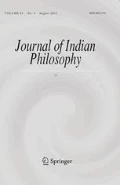REFERENCES
Anathakrishna Iyer, L.K. (1969). The Cochin Tribes and Castes (2 vols.). New York: Johnson Reprint Corp. (First ed. Madras 1909–1912: Higginbotham/Government of Cochin).
Babb, Laurence A. (1983). ‘Destiny and Responsibility: Karma in Popular Hinduism’, in C.F. Keyes and E.V. Daniel (eds.), Karma. An Anthropological Inquiry, pp. 163–181. Berkeley: University of California Press.
Carstairs, G.M. and R.L. Kapur (1976). The Great Universe of Kota. Stress, Change and Mental Disorder in an Indian Village. Berkeley: University of California Press.
Daniel, E. Valentine (1983). ‘Conclusion: Karma, the Uses of an Idea’, in C.F. Keyes and E.V. Daniel (eds.), Karma. An Anthropological Inquiry, pp. 287–300. Berkeley: University of California Press.
Favret-Saada, Jeanne (1977). Les mots, la mort, les sorts. La sorcellerie dans le Bocage. Paris: Gallimard, Bibliothèque des Sciences Humaines.
Fawcett, F. (1915). ‘Nāyars of Malabar’, Madras Government Museum Bulletin, III3 (First print 1901).
Freeman, John R., Jr. (1991). Purity and Violence: Sacred Power in the Teyyam Worship of Malabar. University of Pennsylvania (Ph.D. Dissertation).
Goudriaan, Teun (1978). Mûyû Divine and Human. A Study of Magic and Its Religious Foundations in Sanskrit Texts, with Particular Attention to a Fragment on Visnu's Mûyû Preserved in Bali. Delhi: Motilal Banarsidass.
Gough, E. Kathleen (1958). ‘Cults of the Dead among the Nayars’, Journal of American Folklore 71(281): 446–478.
Govindan, Krishnalayam M.K. (1987). Praśnamārgga \(\underset{\raise0.3em\hbox{$\smash{\scriptscriptstyle\cdot}$}}{m} \) (pūrvvārdha \(\underset{\raise0.3em\hbox{$\smash{\scriptscriptstyle\cdot}$}}{m} \). Kottayam: N.B.S.
Hiebert, Paul G. (1983). ‘Karma and Other Explanation Traditions in a South Indian Village’, in C.F. Keyes and E.V. Daniel (eds.), Karma. An anthropological Inquiry, pp. 119–130. Berkeley: University of California Press.
Jagathambika, R. (1968). A Case Study of Multiple Personality or PossessionSyndrome. Its Aetiology and Treatment. Alwaye: Union Christian College. Unpublished Ph.D. Thesis.
Kakar, Sudhir (1982). Shamans, Mystics and Doctors. A Psychological Inquiry into India and Its Healing Traditions. New York: Alfred Knopf.
Kapur, Sohaila (1983). Witchcraft in Western India. Bombay: Orient Longman.
Kolenda, Pauline (1964). ‘Religious Anxiety and Hindu Fate’, Journal of Asian Studies 23: 71–82.
Kottarattil Sankunni (1974). Aitihyamāla. Kottayam: Kottarattil Sankunni Memorial Committee (First ed.: 1909–1934).
Krishna Ayyar, K.V. (1928). ‘Chathan: A Devil or a Disease?’ Man 28: 151–153.
Lewis, I.M. (1986). Religion in Context. Cults and Charisma. Cambridge University Press.
Lynch, Owen M. (1990). ‘The social Construction of Emotion in India’, in O.M. Lynch (ed.), Divine Passions. The Social Construction of Emotion in India, pp. 3–34. Berkeley: University of California Press.
Malamoud, C. (1992). ‘La colère et la désir dans le système des passions royales de l'Inde ancienne’, Psychiatrie franÇaise 23: 8–14.
Mariadassou, P. (1937). Médecine traditionnelle de l'Inde: la magie noire. Pondichéry: the author.
Mohan, Lakshmi (1981). ‘Voodoo and Black Magic. Exorcism in the Backwaters of Kerala’, The India Magazine 6 (May, 1981): 52–60.
Nichter, Mark (1992). ‘Of Ticks, Kings, Spirits, and the Promise of Vaccines’, in C. Leslie and A. Young (eds.), Paths to Asian Medical Knowledge, pp. 224–253. Berkeley: University of California Press.
Nuckolls, Charles W. (1981). ‘Interpretations of the Concept of Karma in a Telugu Fishing Village’, The Eastern Anthropologist 34(2): 95–106.
Obeyesekere, Gananath (1975). ‘Sorcery, Premeditated Murder, and the Canalization of Aggression in Sri Lanka’, Ethnology 14(1): 1–23.
Padmanabha Menon, K.P. (1937). History of Kerala, vol. 4. Ernakulam: Cochin Government Press (reprint 1986, New Delhi, Asian Educational Services).
Pandya, Mukul (1982). ‘Occultism in an Urban Community’, The Eastern Anthropologist 35(4): 319–322.
Pannikkar, K.M. (1918). ‘Some Aspects of Nayar Life’, JRAI 48: 254–293.
Parpola, Asko (1999). ‘The Iconography and Cult of Ku\(\underset{\raise0.3em\hbox{$\smash{\scriptscriptstyle\cdot}$}}{t} \)iccāttan: Field Research on the Sanskritization of Local Folk Deities in Kerala’, in J. Bronkhorst and M.M. Deshpande (eds.), Aryan and Non-Aryan in South Asia. Evidence, Interpretation and Ideology, pp. 175–205. Cambridge, MA, Harvard Oriental Series.
Pocock, D.F. (1973). Mind, Body and Wealth. A Study of Belief and Practice in an Indian Village. Oxford: Basil Blackwell.
Sharma, Ursula (1973). ‘Theodicy and the Doctrine of Karma’, Man n.s. 8(3): 347–364.
Tarabout Gilles (1986). Sacrifier et donner àvoir en pays malabar. Les fêtes de temple au Kérala (Inde du Sud): étude anthropologique. Paris: E.F.E.O., vol. 147.
Tarabout Gilles (1992). ‘Quand les dieux s'emmêlent. Point de vue sur les classifications divines au Kérala’, in Bouillier and Toffin (eds.), Classer les Dieux? Des panthéons en Asie du Sud. Paris: E.H.E.S.S. (Purusartha 15).
Tarabout Gilles (1994). ‘Violence et non-violence magiques: la sorcellerie au Kérala’, in Meyer, Tarabout and Vidal (eds.), Violences et non-violences en Inde. Paris: E.H.E.S.S. (Purusartha 16).
Tarabout Gilles (1997). ‘Maîtres et serviteurs. Commander à des dieux au Kérala (Inde du Sud)’, in A. de Surgy (ed.), Religion et pratiques de puissance, pp. 253–284. Paris: L'Harmattan.
Thaliath, Joseph (1956). ‘Notes on Some Pulaya Customs and Beliefs’, Anthropos 51: 1029–1054.
Türstig, Hans-Georg (1985). ‘The Indian Sorcery Called Abhicâra’, WZKS 29: 69–117.
Unni Nayar, M.K. (1952). My Malabar. Bombay: Hind Kitabs Limited.
Vincentnathan, Lynn (1993). ‘Untouchable Concepts of Person and Society’, C.I.S. n.s. 27(1): 53–82.
Zimmermann, Francis (1991). ‘The Love-Lorn Consumptive: South Asian Ethnography and the Psychosomatic Paradigm’, Curare, Anthropologies of Medicine, Special Issue 7/91: 185–195.
Author information
Authors and Affiliations
Rights and permissions
About this article
Cite this article
Tarabout, G. ``Passions'' in the Discourses on Witchcraft in Kerala. Journal of Indian Philosophy 28, 651–664 (2000). https://doi.org/10.1023/A:1017599113038
Issue Date:
DOI: https://doi.org/10.1023/A:1017599113038

